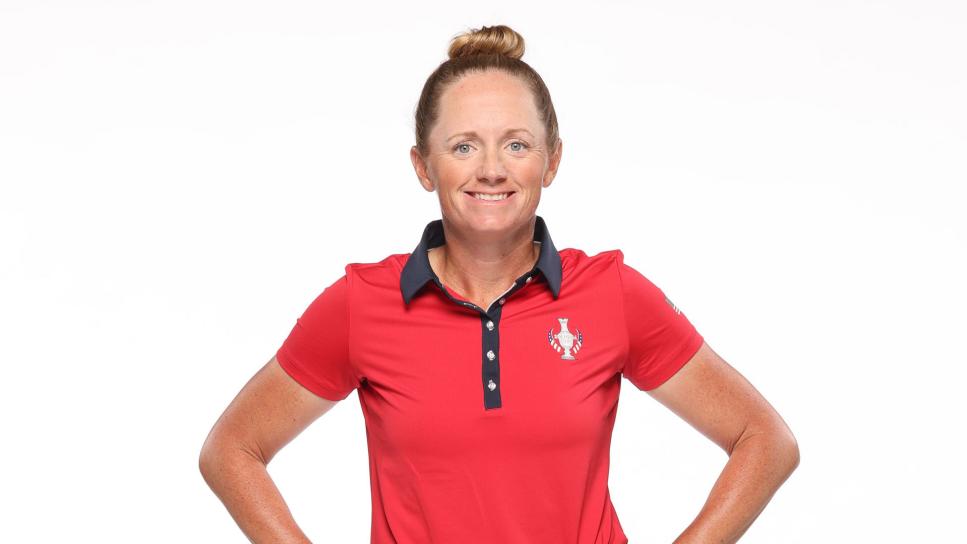The Solheim Cup presents a unique challenge for the United States team as it settles in Spain attempting to prevent the prolonging of an unprecedented losing streak. Should the Americans fall to their European rivals at Finca Cortesin—after losses in 2019 at Gleneagles in Scotland and in 2021 at Inverness Club in Ohio—it would be the first time since the inception of the competition in 1990 that the U.S. had been beaten in three straight Solheim Cups. It also would mark a fifth defeat in the past seven matches dating back to 2013, another frustrating first.
Faced with stopping the Americans’ slide on foreign soil and crucially flipping the momentum of the matches, U.S. captain Stacy Lewis has spent plenty of time processing the gravity of what this year’s Solheim Cup means for her team and its future.
“I’ve thought a lot about, Do we have to win?” Lewis told Golf Digest. “Like, is this a must-win? What is this? And I don’t know that it is. I mean, we lost in Gleneagles by one shot. We lost [at Inverness] by probably two or three shots. So it really hasn’t been far off. And I think every Solheim Cup going forward is going to be tight like this.”
Lewis’ memory of 2019 was spot on as, coincidentally, her rival captain this year, Suzann Pettersen, famously holed the final putt of her competitive career on the 18th green in the deciding match at Gleneagles to keep the Americans from closing out a three-peat of their own. But in 2021 at Inverness, Europe clinched the Cup with five singles games still on the course, an inconsequential comeback resulting in a 15-13 European victory that looked closer than it really was.
How exactly to turn things around, of course, is Lewis’ riddle to solve. A four-time Solheim Cup participant, the 38-year-old Texan has spent much of the 19 months since being named captain working with analytics specialists to identify the players and pairings that would give the U.S. the best chance at success. Lewis won’t get into specifics on her gameplan—keeping it hush-hush before putting it in place with the start of play on Friday—but believes inside the numbers lies the key to squeezing out every last bit of performance from her team.
Given Europe’s recent victories, combined with an influx of young Americans emerging on the LPGA, Lewis’ team has just three players who have played on a winning U.S. Solheim Cup squad: Lexi Thompson (2015, 2017), Danielle Kang (2017) and Angel Yin (2017). Three others—Megan Khang, Nelly Korda and Ally Ewing—have all been on the past two losing rosters. Meanwhile, five players will be making their Solheim debuts: Allisen Corpuz, Cheyenne Knight, Andrea Lee, Lilia Vu and Rose Zhang.
The good news? Frustration might become a source of motivation for the holdovers. “At some point, you just get tired of it,” U.S. assistant captain Angela Stanford said. “And I think some of these ladies are hitting that point. Where it’s like, OK, you know, you lose one. And then you lose another one, and you’re like, Well, that could have gone our way. But then you’re kind of tired of it. Kind of tired of losing. So, I think we’re there.”
Indeed, for those who are returning, there is a sense that enough is enough. “This is where we want to take it back, especially on European soil,” Yin said. “I think it would mean a lot when we take that Cup back, especially what happened at Gleneagles with Suzann making that last putt to essentially win the Cup when it was just a putt difference.”
“Everything [is on the line],” Khang said. “I think the USA is more hungry than ever.”
Mind you, data will only get you so far. Execution is what will be needed for the U.S. to overcome their rivals. All the number-crunching doesn’t do any good if Korda or Kang struggle holing putts.
Arguably, the best strategy to deliver on the execution is to figure out a way to turn down the heat and allow the players to feel at ease, particularly those competing for the first time. Eight of the 12 on this year’s team are 26 and younger, including all five rookies.
“It’s a super young team, and it’s kind of the changing of the guards,” three-time U.S. Solheim Cup captain Juli Inkster said. “I think Stacy is the perfect person to lead that charge.”
Should things not go the Americans way, the resulting scenario for the next Solheim Cup becomes even more foreboding than the one facing Lewis and crew this week. The next match will be played 354 days after the finish in Spain, the matches returning in 2024 to allow the event to be held in even years so as not to conflicting with the Ryder Cup after it was delayed a year due to COVID. The condensed run-up means that both Lewis and Pettersen will return as captains. And Europe would arrive at the Robert Trent Jones Golf Club in Manassas, Virginia, holding all the momentum as it continues to close the gap against the U.S. overall lead (10-8) with a chance to be the first country to four-peat.
“If we’re in that boat, I think there probably is a little bit more pressure,” Lewis said. “The question becomes, too, is: what does the European team look like at that point? Whether they have a lot of changes, a changing of the guard.”
However, contemplating all of the implications of this Solheim Cup’s outcome and how the rosters might shake out are issues to grapple with come September 2024. The American focus remains on the pressing problem of grabbing hold of the Cup for the first time in six years.
“That’s a lot of thinking,” Yin laughed while explaining. “I don’t think we can think that far, because when we think that far, then it’s too many thoughts. So I think when the ball and the tee goes into the ground and the ball goes in the air, that’s all we have focused to beat whoever we’re playing against.”
This article was originally published on golfdigest.com





